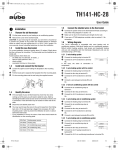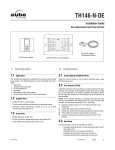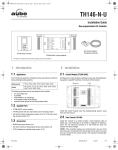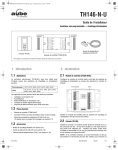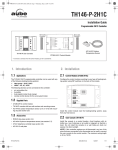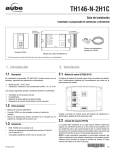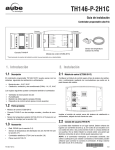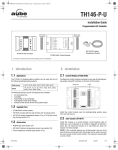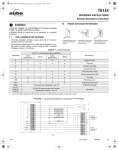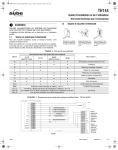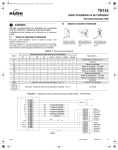Download Aube Technologies TH146-P-2H1C Installation guide
Transcript
TH146-P-DE Installation Guide Programmable Heat Pump Controller - TH146-P User Console AC144-03 Outdoor Temperature Sensor CT280-HP-2H1C Control Module 1. Introduction 2. Installation 1.1 2.1 Applications The TH146-P-DE programmable controller can be used to control a heat pump system. The following devices can be connected to the controller: heat pump auxiliary heating (furnace) air recirculation fan humidifier dual-register meter (dual energy) remote control device (for the unoccupied mode) 1.2 Supplied Parts Control Module (CT280-HP-2H1C) Install the control module on the furnace’s electrical panel, away from the heat source. 2.2 User Console (TH146-P) Install the console in the area where you wish to measure the temperature and humidity. Avoid locations where there are air drafts (e.g., top of staircase or air outlet) or stagnant air (behind a door). Do not install the console on a wall hiding air ducts nor expose it to direct sunlight. • CT280-HP-2H1C control module NOTE: If this controller replaces an existing thermostat, the wires that were connected to the thermostat can be used to connect the console. The maximum wire length is 30 m (100 feet). • TH146-P console with two wall anchors and mounting screws 1) • AC144-03 outdoor temperature sensor (3 m or 10 ft) with mounting clip (see section 2.7) 1.3 Accessories • RC845 relay (see section 2.5) • AC146-410 plenum temperature sensor (see section 2.8) • CT241 telephone controller (see section 2.10) 2) 3) 4) 5) Choose a location about 5 ft. (1.5 m) above the floor on an inside wall. Loosen the captive screw under the console. Detach the console from its base by pulling the bottom section. Secure the base using the wall anchors and screws. Connect the console to controller terminals TH and TH (no polarity). 2.3 Heat Pump Connect the heat pump to the controller as follows: • Controller terminals R and C to heat pump terminals R and C (see section 2.4) • Controller terminal Y to heat pump terminal Y • Controller terminal O/B to heat pump terminal O • Controller terminal WW to heat pump terminal WW TH146-P-DE 400-280-004-C 11/29/06 1/9 • Controller terminal L to heat pump terminal L • Controller terminal W to heat pump terminal W (see section 2.5) • Controller terminal G to heat pump terminal G (see section 2.5) 2.4 24 V Transformer You might need a 24 V transformer if you have an add-on installation. Connect the transformer to the controller terminals R and C (24 Vac In). 2.5 RC845 Relay If you have an add-on installation, you might need a relay such as Aube’s RC845 to connect the furnace (auxiliary heating) and its fan to the controller. Install the relay near the control module. Connect the wires of the RC845 relay as follows: • relay terminals W, G and C to controller terminals W, G and C. • relay terminals T and T to the appropriate furnace terminals: T and T (oil); TH and TH (gas); R and W (electric). NOTE: Refer to the relay’s installation instructions for more details. 2.6 Humidifier Connect the humidifier to controller terminals C and H (no polarity). 2.7 Outdoor Sensor (AC144-03) The outdoor sensor is required for the following: • balance points • automatic humidity control • outdoor temperature display • defrost point When installing the sensor, observe the following guidelines: • Avoid locations where the sensor can be covered with snow or exposed to direct sunlight. • Avoid air outlets and concealed chimneys or stove pipes. Install the sensor using its mounting clip and connect it to controller terminals OS and CS (no polarity). 2.9 Dual-energy Input The dual-energy input can be connected to the dual-register meter equipped with a normally open (NO) dry contact. Connect the terminals DE and CC of the controller to the terminals (yellow and red wires) of the dual-register meter. When the contact is open, the heat pump and auxiliary heating operate as usual. The contact closes when the outdoor temperature drops below the set threshold. When the contact is closed, the heat pump is disabled and only the auxiliary heat can be used. 2.10 Unoccupied Mode Input To use the unoccupied mode, the controller requires a remote control device such as Aube’s telephone controller CT241 equipped with a dry-contact output (normally open). The unoccupied mode is activated when the contact closes. (See section 6.4.) 2.11Wiring Table 24 Vac In Plenum Sensor (AC146-410) The plenum sensor measures the temperature inside the plenum. This data is required for high pressure protection during the defrost cycle (see section 4.3). NOTE: The plenum sensor is generally needed for add-on installations only. It is not needed if the heat pump is not connected to the controller terminal WW. Install the sensor on the side of the plenum and position it such that its aperture faces the air flow. Connect the sensor to controller terminals PS and CS (no polarity). For more information, refer to the instructions provided with the sensor. NOTE: The maximum wire length is 30 m (100 feet). TH146-P-DE Power; 24 Vac Thermostat TH TH Console connection Plenum Sensor PS CS Plenum temperature sensor connection Outdoor Sensor OS CS Outdoor temperature sensor connection Dual Energy DE CC Dual energy connection (requires a normally open contact) Unoccupied UN CC Unoccupied mode connection (requires a normally open contact) Heat Pump R C Power; 24 Vac / 3 A Y Output; 24 Vac / 1 A (compressor) O/B Output; 24 Vac / 1 A (reversing valve; energized on cool) WW Input; 24 Vac / 2 mA (defrost) L Input; 24 Vac / 2 mA (fault) Aux. Heat W G Output; 24 Vac / 1 A (auxiliary heat and fan) Humidifier C H Output; 24 Vac / 1 A NOTE: The maximum wire length is 30 m (100 feet). 2.8 R C 3. Configuration 3.1 Switch Configuration To access the 2 configuration switches, loosen the captive screw under the console and separate the console from its base by pulling the bottom section. 3.1.1 Keypad Lock (SW1) I: The keypad is locked. Settings cannot be changed. O: The keypad is unlocked. 3.1.2 Access Mode (SW2) INST: Installer mode. Gives access to all configuration parameters. 400-280-004-C 11/29/06 2/9 NOTE: In this mode, the short-cycle protection is disabled and the interstage delay is reduced to 1 minute. USER: User mode. Gives access to configuration parameters 1 to 4 only. 3.2 n o p q r s Software Configuration Place the controller in Installer mode (INST) using the SW2 selector switch on the back of the console. Press the Mode button for 3 seconds to access the configuration menu (see page 4). The first menu item (parameter) is displayed. To view another menu item, briefly press the Mode button. The following table shows the order in which the parameters appear as well as a description of each parameter. To modify a parameter, press either button. To exit the configuration menu, press 4. Principles of Operation Automatic Heating/Cooling Changeover With automatic changeover, there’s no need to adjust the controller at every change of season or weather condition. The controller switches automatically between heating mode and cooling mode to maintain the desired temperature. 4.3 • When the outdoor temperature is above the defrost point (see page 4, item 7). NOTE: This condition will not apply if the AC144-03 outdoor temperature sensor is not connected to the controller. • When the plenum temperature is above 40°C (104°F). The auxiliary heat is re-activated when the plenum temperature drops below 32°C (90°F). NOTE: This condition will not apply if the AC146-410 plenum sensor is not connected to the controller. NOTE: The auxiliary heat’s short-cycle protection is disabled during defrost. 4.4 Types of Heat Pump Installations The controller can be configured for either of the following types of heat pump installations (see page 4, item 8). • When the controller is in manual mode, the heating/cooling mode changeover occurs as follows: The controller switches to cooling mode when the indoor temperature is higher than the setpoint by more than 1.5°C (2.5°F) for 15 minutes. • The controller switches the heating mode when the indoor temperature is lower than the setpoint by more than 1.5°C (2.5°F) for 15 minutes. Automatic Mode Heating During Defrost The auxiliary heat is activated during defrost except under the following conditions: Manual Mode • When the outdoor temperature is above the balance point high (bP H), the auxiliary heat is disabled (see page 4, item 6) and only the heat pump can be used. NOTE: Balance points will not work if the AC144-03 outdoor temperature sensor is not connected to the controller. . Return the controller to User mode (USER) using the SW2 selector switch. 4.1 • • Add-on Installation: This type of installation is performed when adding a heat pump to an existing furnace. When the heat pump is installed, the furnace becomes the auxiliary heat source. In this type of installation, the indoor coils are usually installed downstream of the auxiliary heat source. When the controller is configured for an add-on installation, the heat pump is disabled during auxiliary heating to prevent overpressure. New Installation: In this type of installation, as there is not already a furnace, the auxiliary heat source is installed at the same time as the heat pump. In this type of installation, the indoor coils are located upstream of the auxiliary heat. When the controller is configured for a new installation, the heat pump and the auxiliary heat can operate simultaneously. 4.5 When the controller is in automatic mode, it follows the programmed schedule. Two temperature settings (heating setpoint and cooling setpoint) are programmed for each period of the schedule. The heating/cooling mode changeover occurs as follows: When “smart fan” is enabled (see page 4, item 10), the fan operates as follows: • • • When the controller is in heating mode, the indoor temperature is maintained at the heating setpoint. However, if the temperature rises and remains above the cooling setpoint for 15 minutes, the controller will switch to cooling mode. When the controller is in cooling mode, the indoor temperature is maintained at the cooling setpoint. However, if the temperature drops and remains below the heating setpoint for 15 minutes, the controller will switch to heating mode. 4.2 Balance Points Balance points are used to disable the heat pump operation or auxiliary heating below or above a certain temperature. • When the outdoor temperature is below the balance point low (bP L), the heat pump is disabled and only auxiliary heating can used (see page 4, item 5). TH146-P-DE “Smart Fan” During the unoccupied mode (i.e., when you are away from home), the fan operates only when heating or cooling is activated. • The fan operates continuously the rest of the time. NOTE: “Smart fan” is useful only when the fan is set to On (see section 5.3). 4.6 Interstage Delay The interstage delay is the time that the temperature has to return to an acceptable value when it deviates too much from the setpoint. After this delay, auxiliary heating is activated. Auxiliary heating will be deactivated once the temperature returns to an acceptable value (see page 4, item 11). 400-280-004-C 11/29/06 3/9 Configuration Menu Item Parameters 1 Time format 2 Early Start Display Options Default 12 Hr / 24 Hr 24 Hr On / OF Description Select the time display format. OF On: Heating or cooling starts in advance (as determined by the controller) so that the desired temperature is attained at the set times. OF (Off): Heating or cooling starts at the set times. NOTE: Early Start applies for periods 1 and 3 (P1 and P3) only. When this feature is enabled, heating or cooling will start in advance of the set time for P1 and P3 but will start at the set time (not earlier) for P2 and P4. OF OF (Off): The normal time is used all year long. 1 : The controller switches to daylight savings time on the first Sunday of April and to normal time on the last Sunday of October. 2 : The controller switches to daylight savings time on the second Sunday of March and to normal time on the first Sunday of November. Select the temperature display format. 3 Automatic daylight savings adjustment 4 Temperature scale °C / °F °C 5 Balance point low -30°C to 10°C (-22°F to 50°F) -10°C (14°F) Set the bP L value (see section 4.2). 6 Balance point high -5°C to 30°C (23°F to 86°F) 5°C (41°F) Set the bP H value (see section 4.2). 7 Defrost point -10°C to 15°C (14°F to 59°F) 10°C (50°F) During defrost, auxiliary heating is activated when the outside temperature is below the defrost point (see section 4.3). OF / 1 / 2 8 Installation type Ad / nr Ad 9 Cycles per hour 2 to 6 4 10 “Smart fan” On / OF OF 11 Interstage delay 5 to 90 min. 10 min. 12 Humidifier operating mode HE / Fn HE Set according to the type of heat pump installation (see section 4.4). Ad (add-on): Use this setting when the indoor coils are located downstream of the auxiliary heat source. This is generally the case for add-on installations. nr (normal): Select this setting when the indoor coils are located upstream of the auxiliary heat source. This is generally the case for new installations. Allows you to select the number of cycles per hour. It is recommended to use the default setting except in exceptional cases. On: “Smart fan” is On (see section 4.5). OF: “Smart fan” is Off. Set the interstage delay (see section 4.6). HE (heat): The humidifier can operate only when heating is activated. Fn (fan): The humidifier can operate as long as the fan is running, whether heating is activated or not. NOTE: The humidifier is disabled when cooling is activated. NOTE: Only items 1 to 4 are available when the controller is placed in user mode (SW2 switch). TH146-P-DE 400-280-004-C 11/29/06 4/9 Connection Diagram — New Installation Heat Pump AC146-410 TH146-P 16 - 22 AWG 16 - 18 AWG Compressor CT280-HP-2H1C Valve Defrost Fault Auxiliary Heat 16 - 22 AWG Fan 16 - 22 AWG Humidifier Dual Energy 16 - 18 AWG CT241 Red Green Yellow AC144-03 16 - 22 AWG 16 - 22 AWG TH146-P-DE 400-280-004-C 11/29/06 5/9 Connection Diagram — Add-on Installation TH146-P Heat Pump 24 V Transformer 16 - 18 AWG AC146-410 16 - 22 AWG Compressor Reversing Valve Defrost CT280-HP-2H1C Fault 16 - 18 AWG 16 - 22 AWG 16 - 22 AWG 16 - 22 AWG 16 - 18 AWG Dual Energy 16 - 18 AWG Furnace AC144-03 16 - 22 AWG Fan Limit Red Green Yellow CT241 Humidifier RC845 16 - 22 AWG TH146-P-DE 400-280-004-C Auxiliary Heating System 11/29/06 6/9 TH146-P-DE User’s Guide Programmable Heat Pump Controller Indicator LEDs Time and day setting Temperature adjustment mode selection Programming Fan operating mode selection Program day selection Program clear System operating mode selection Humidity setting Up/Down buttons Return Indicator LEDs Day FAULT: System fault EH: Emergency heat mode DE: Dual-energy mode Clock Backlight Indoor temperature During normal display, the screen illuminates for 12 seconds when any button is pressed. When the controller is being configured, the screen remains lit until it returns to normal display. Indoor humidity Outdoor temperature 5. General Setting 6. Temperature Setting 5.1 6.1 n o p q r s t Press Clk. The hour display flashes. Set the hour using . Press Clk. The minute display flashes. Set the minutes using Set the day using Press Heating is On Cooling is On System operating mode Auxiliary heating is On . to return to the normal display. Date Setting Set the year using . Press Clk to display the month. Set the month using . Press Clk to display the date. Set the date using Press . to return to the normal display. Fan Operating Mode Press the Fan button to select the fan operating mode. • Indoor temperature Temperature adjustment mode (appears when the controller is in automatic mode, disappears when it is in manual mode) Fan operating mode (appears when the fan is in continuous mode, disappears when it is in automatic mode) Press Clk for 3 seconds to display the year. 5.3 • Display Appears when the temperature setpoint is displayed . Press Clk. The day display flashes. 5.2 n o p q r s t Clock and Day Setting In automatic mode, the fan runs only when heating or cooling is activated. In continuous mode, the fan runs continuously and the symbol is displayed. NOTE: If the “smart fan” feature is enabled, the fan will run only when heating or cooling will be activated during unoccupied mode. TH146-P-DE The controller normally displays the measured indoor temperature. To view the setpoint, press one of the buttons. The setpoint will be displayed along with the symbol for the next 5 seconds. 6.2 System Operating Mode Press Mode to place the system in one of the following modes: HEAT The system is in heating mode. COOL The system is in cooling mode. AUTO The system is in automatic changeover. (The system switches between heating mode and cooling mode to maintain the desired temperature.) OFF Both heating or cooling are off. EHEAT The system is in emergency heat mode. Only auxiliary heating is used when there is a call for heat. 400-280-004-C 11/29/06 7/9 6.3 • Temperature Adjustment 6.3.1 Manual Adjustment Use this adjustment mode to set the temperature manually. To place the controller in this mode, press Auto/Man so that disappears from the screen and set the temperature using the buttons. NOTE: If the controller is in automatic heat/cool changeover, the setpoint is automatically lowered or raised by 1°C (2°F) when the controller switches to heating mode or to cooling mode respectively. For example, if you place the setpoint at 24°C (75°F) while in heating mode, the setpoint will become 25°C (77°F) in cooling mode and will return to 24°C (75°F) when the controller switches back to heating mode. Press Pre-programmed Schedule P1 Heating 21°C (70°F) Cooling 25.5°C (78°F) P2 Heating 16.5°C (62°F) Cooling 29.5°C (85°F) P3 Heating 21°C (70°F) Cooling 25.5°C (78°F) P4 Heating 16.5°C (62°F) Cooling 28°C (82°F) MO TU WE TH FR SA SU 6:00 a.m. 8:00 a.m. -- 6:00 p.m. -- 10:00 p.m. Modifying the Schedule You can program up to 4 periods per day. For each period, you can set the start time, the heating mode setpoint and the cooling mode setpoint. The program can be different for each day of the week. • Press Pgm to enter the programming mode. The settings for Monday, Period 1 (P1) appear. • To select a day to program, press Day until the day is displayed. Press Day for 3 seconds to select all 7 days. NOTE: If you select all 7 days, the settings of the displayed period will be copied to all 7 days. For example, if period 1 is displayed and you then select all 7 days , they will all now have the same settings for period 1. If you display period 2 while all 7 days are selected, they will all now have the same settings for period 2. • Day Heat 21 Mode Pgm P1 Cool Heat 25.5 21 MO TU 8:00 8:00 Pgm P2 16.5 Mode Cool 25.5 Pgm Pgm Heat Mode Day Pgm P2 Cool Heat 29.5 16.5 Mode Cool 29.5 Temporary Bypass When you modify the temperature setpoint while the controller is in automatic mode, the new temperature is used for the next 2 hours. The icon flashes during the bypass. After the bypass, the temperature set for the current period is used. 6.4 Unoccupied Mode The controller can be placed in unoccupied mode via a remote control device such as Aube’s CT241 telephone controller (see section 2.10). In this mode, the setpoint is set back by 4.5°C (8°F); it is lowered in heating mode or raised in cooling mode. The message UNOC appears during the unoccupied mode. NOTE: Automatic changeover is disabled during the unoccupied mode. Temporary Bypass In unoccupied mode, only the buttons work. When you adjust the temperature during this mode, the new temperature will be used for the next 2 hours, after which the controller will return to the previous setpoint. The message UNOC flashes during the bypass. 7. Humidity Setting 7.1 Display To set the start time of a period, first press Pgm until the period number (P1 to P4) is displayed and the time display flashes. Then press the buttons. The time changes in increments of 15 minutes. NOTE: During programming, to skip a period press Clr while the period is selected. For example, in the pre-programmed schedule, periods 2 and 3 have been skipped for Saturday and Sunday. • TU 6:00 Pgm Pre-programmed Schedule NOTE: When programming the heating setpoint, it cannot be higher than 1°C (2°F) below the cooling setpoint. For example, if the cooling setpoint is 25°C (77°F), the highest you can place the heating setpoint is 24°C (75°F). Conversely, when programming the cooling setpoint, it cannot be lower than 1°C (2°F) above than the heating setpoint. MO 6:00 P1 6.3.2 Automatic Adjustment Use this adjustment mode if you want the controller to automatically adjust the temperature according to the programmed schedule. To place the controller in this mode, press Auto/Man so that appears on the screen. The following schedule has been programmed at the factory. Two temperature settings are programmed for each period of the schedule: one is used in heating mode and the other in cooling mode. to exit. The following diagram shows how to navigate the programming menu. To set the temperature for a period, first press Pgm until the period number (P1 to P4) is displayed and the temperature display flashes. Then press Mode to select the heating mode setpoint display or the cooling mode setpoint. Finally press the buttons. TH146-P-DE Humidity level The arrow appears when the humidity setpoint is displayed Humidifier is On Humidity control mode (auto, manual or off) 400-280-004-C 11/29/06 8/9 7.2 Humidity Adjustment Manual Adjustment In manual adjustment, the humidity level is set by the user (5% to 60%). n o p Press the Hum button until MAN appears on the screen. Press one of the buttons to adjust the humidity level. Press the button to return to normal display. Automatic Adjustment In automatic adjustment, the humidity level is set by the controller based on the outdoor temperature to prevent ice formation or condensation on the windows while providing enough humidity for your comfort. However, the user can apply an offset (-9% to 9%). For example, the user can enter a negative offset if there is still ice formation or condensation on the windows. n Press the Hum button until AUTO appears on the screen. The current humidity level set by the controller is also displayed. o p Press one of the Press the buttons to place or modify the offset. button to save and exit the programming. Off To turn off the humidity control: n o Press the Hum button until OFF appears on the screen. Press the button to save and exit the programming. 8. Technical Specifications CT280-HP-2H1C Control Module Power supply: 24 VAC Current consumption: 150 mA Maximum load per output: 1 A @ 24 VAC Short cycle protection: 2 minutes Control cycles: 2 to 6 per hour Operating temperature: 0°C to 50°C (32°F to 122°F) Storage temperature: -20°C to 50°C (-4°F to 122°F) Humidity conditions: 0% to 95%, non-condensing Dimensions: 76 mm x 109 mm x 25 mm (3 in. x 4.3 in. x 1 in.) TH146-P Console Temperature setpoint range Heating mode: 5°C to 30°C (40°F to 86°F) Cooling mode: 15°C to 40°C (59°F to 104°F) Humidity setpoint range: 5% to 60% Indoor temperature display range: 0°C to 70°C (32°F to 158°F) Outdoor temp. display range: -50°C to 70°C (-58°F to 158°F) Temperature display resolution: 0.5°C (1°F) Program protection: non-volatile memory Operating temperature: 0°C to 50°C (32°F to 122°F) Storage temperature: -20°C to 50°C (-4°F to 122°F) Humidity conditions: 0% to 95%, non-condensing Dimensions: 79 mm x 79 mm x 24 mm (3.1 in. x 3.1 in. x 1 in.) vice, for a period of three (3) years from the date of purchase by the consumer. If at any time during the warranty period the product is determined to be defective or malfunctions, Aube shall repair or replace it (at Aube's option). If the product is defective, (i) return it, with a bill of sale or other dated proof of purchase, to the place from which you purchased it, or (ii) contact Aube. Aube will make the determination whether the product should be returned, or whether a replacement product can be sent to you. This warranty does not cover removal or reinstallation costs. This warranty shall not apply if it is shown by Aube that the defect or malfunction was caused by damage which occurred while the product was in the possession of a consumer. Aube's sole responsibility shall be to repair or replace the product within the terms stated above. AUBE SHALL NOT BE LIABLE FOR ANY LOSS OR DAMAGE OF ANY KIND, INCLUDING ANY INCIDENTAL OR CONSEQUENTIAL DAMAGES RESULTING, DIRECTLY OR INDIRECTLY, FROM ANY BREACH OF ANY WARRANTY, EXPRESS OR IMPLIED, OR ANY OTHER FAILURE OF THIS PRODUCT. Some provinces and states do not allow the exclusion or limitation of incidental or consequential damages, so this limitation may not apply to you. THIS WARRANTY IS THE ONLY EXPRESS WARRANTY AUBE MAKES ON THIS PRODUCT. THE DURATION OF ANY IMPLIED WARRANTIES, INCLUDING THE WARRANTIES OF MERCHANTABILITY AND FITNESS FOR A PARTICULAR PURPOSE, IS HEREBY LIMITED TO THE THREE-YEAR DURATION OF THIS WARRANTY. Some provinces and states do not allow limitations on how long an implied warranty lasts, so the above limitation may not apply to you. This warranty gives you specific legal rights, and you may have other rights which vary by province or state. 10.Support If you have any questions about the product installation or operation, or concerning the warranty, contact us at the address shown below. 705 Montrichard Saint-Jean-sur-Richelieu, Quebec J2X 5K8 Canada Tel: (450) 358-4600 Toll-free: 1-800-831-AUBE Fax: (450) 358-4650 Email: [email protected] 10, rue Ampère 95500 Gonesse France Tel: 33 (0) 1 34 07 99 00 Fax: 33 (0) 1 34 07 99 19 Email: [email protected] For more information on our products, visit us at: www.aubetech.com ® As an ENERGY STAR partner, Aube Technologies has determined that this product meets the ENERGY STAR guidelines for energy efficiency. 9. Warranty Aube warrants this product, excluding battery, to be free from defects in the workmanship or materials, under normal use and serTH146-P-DE 400-280-004-C 11/29/06 9/9









